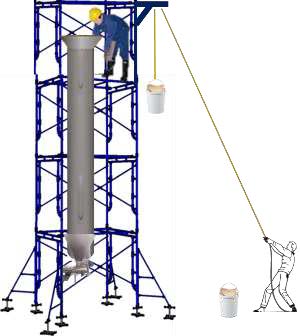การออกแบบและพัฒนาเครื่องนึ่งข้าวเปลือกแบบต่อเนื่องสำหรับการแปรรูปข้าว | Design and Development of the Continuous Steamer for Rice Processing
##plugins.themes.bootstrap3.article.main##
บทคัดย่อ
This research aimed to design and develop the continuous paddy steaming machine for hang rice or parboiled rice production which was acceptable to community and small enterprises. The machine was made of stainless steel with 150 kg loading capacity of soaked paddy. The initial moisture content of soaked paddy was 31.14±0.78 % (w.b.) then, the soaked paddy was steamed in the designed steamer and the temperature of pressurized steam was set at 109.5 °C (40 kPa). The steaming time of paddy was controlled by speed of the screw conveyor. The screw speed was 10.2, 15.4 and 20.6 rpm according to the frequencies of the variable frequency drives (inverter) at 5, 7.5 and 10 Hz respectively. The sample of paddy was collected at the first 15 minutes after steam valve and screw conveyor were operated. The sample of steamed paddy was collected every 10 minutes until 105 minutes. After drying, the quality of steamed paddy was determined, i.e. moisture content, head rice yield of brown rice, head rice yield of milled rice, color and chalky kernels. The results showed that the production capacity of the steamer was 0.70±0.01, 1.06±0.01 and 1.42±0.07 kg/min at the screw speed 10.2, 15.4 and 20.6 rpm respectively. Increasing of steaming time raised the percentage of head rice yield and the yellow color value of parboiled rice increased but reduced the percentage of chalky kernels. The suitable condition for streaming the RD31 paddy was 15.4 rpm of screw conveyor and at least 35 min of steaming time. At this condition, the head rice yield of brown parboiled rice and milled parboiled paddy was 69.67±1.67% and 65.83±1.84% respectively. The designed machine could decrease the percentage of chalky kernels and increase the yellow value (b*) of the parboiled rice. The parboiled rice obtained from the speed of screw conveyor at 15.4 rpm had uniform quality and showed the same trend with the result from other researchers.
บทคัดย่อ
งานวิจัยนี้มีวัตถุประสงค์ในการออกแบบและพัฒนาเครื่องนึ่งข้าวเปลือกแบบต่อเนื่องสำหรับการผลิตข้าวฮาง ข้าวนึ่ง หรือข้าวกล้องนึ่งเพาะงอก เพื่อวิสาหกิจชุมชนและอุตสาหกรรมขนาดเล็ก โดยเครื่องนึ่งข้าวทำด้วยสแตนเลส สามารถบรรจุข้าวเปลือก (กข31) หลังแช่น้ำได้ประมาณ 150 kg หลังการแช่ข้าวนึ่งมีความชื้นที่ 31.14±0.78 % (w.b.) แล้วนึ่งด้วยเครื่องที่ออกแบบ โดยใช้ไอน้ำอุณหภูมิในการนึ่งที่ 109.5 °C (ความดัน 40 kPa) และควบคุมเวลานึ่งด้วยความเร็วของสกรูลำเลียงออกโดยการปรับอินเวอร์เตอร์ที่ความถี่ 3 ระดับคือ 5 7.5 และ 10 Hz ได้ความเร็วรอบสกรูที่ 10.2 15.4 และ 20.6 rpm ตามลำดับ ในการทดลองเริ่มเก็บตัวอย่างแรกหลังจากเปิดไอน้ำเข้าเครื่อง และเปิดสกรูลำเลียงที่ความเร็วต่างๆ ที่เวลา 15 นาที และเก็บตัวอย่างทุก 10 นาที จนถึง 105 นาที หลังจากข้าวแห้งแล้วนำข้าวที่ได้ไปสีเพื่อตรวจสอบคุณภาพ ของข้าวนึ่ง (ความชื้นหลังการลดความชื้น เปอร์เซ็นต์ต้นข้าวกล้องนึ่งเปอร์เซ็นต์ต้นข้าวสาร สี และเปอร์เซ็นต์ข้าวท้องไข่) ผลการศึกษาระดับความเร็วรอบของสกรูที่ 10.2 15.4 และ 20.6 rpm มีอัตราการผลิตเท่ากับ 0.70±0.01 1.06±0.01 และ1.42±0.07 kg/min ตามลำดับ และเมื่อใช้เวลาในการนึ่งนานขึ้น ค่าเปอร์เซ็นต์ต้นข้าวและ ค่าสีเหลือง ของเมล็ดข้าวนึ่งจะเพิ่มขึ้น แต่เปอร์เซ็นต์ข้าวท้องไข่ลดลง โดยสภาวะที่เหมาะสมสำหรับการนึ่งข้าวเปลือกพันธุ์ กข31 คือ การนึ่งที่ความเร็วรอบ 15.4 rpm ที่ใช้เวลาตั้งแต่ 35 นาที โดยมีเปอร์เซ็นต์ต้นข้าวกล้องนึ่ง 69.67±1.67 และ เปอร์เซ็นต์ต้นข้าวสารเป็น 65.83±1.84 ตามลำดับ โดยข้าวมีค่าความเป็นสีเหลืองเพิ่มขึ้น และสามารถลดเปอร์เซ็นต์ข้าวท้องไข่ของข้าวได้ โดยการนึ่งข้าวความเร็วของสกรูที่ 15.4 rpm ทำให้ข้าวที่ได้จากการทดลองมีคุณภาพสม่ำเสมอ และ มีแนวโน้มที่เป็นไปในแนวทางของนักวิจัยอื่น
##plugins.generic.usageStats.downloads##
##plugins.themes.bootstrap3.article.details##
เอกสารอ้างอิง
จักรวาฬ จันทร์หล้า. (2554). การจัดการภูมิปัญญาท้องถิ่นข้าวฮาง ในการทำข้าวฮางของกลุ่มผลิตข้าวฮาง ในเขตเทศบาลตำบลปลาโหล อำเภอวชิรภูมิ จังหวัดสกลนคร. (น. 213). รายงานการศึกษาอิสระปริญญารัฐประศาสนศาสตร์มหาบัณฑิต มหาวิทยาลัย
ขอนแก่น.
พิมพ์พรรณ ปรืองาม, สมชาติ โสภณรนฤทธิ์, สมเกียรติ ปรัชญาวรากร, และสักกมน เทพหัสดิน ณ อยุธยา. (2560). การปรับปรุงกระบวนการแช่ด้วยการพ่นไอน้ำเพื่อลดเวลาการผลิตข้าวนึ่ง วารสารวิชาการพระจอมเกล้าพระนคร, 27(4), 655-665.
มุทิตา มีนุ่น และวัชรี สีห์ชำนาญธุระกิจ. (2559) ผลของกระบวนการนึ่ง และระดับการขัดสีต่อคุณสมบัติของข้าวสังข์หยด รวมมาตรฐานสินค้าข้าวไทย. (น. 93). นนทบุรี: กองมาตรฐานสินค้านำเข้าส่งออก กรมการค้าต่างประเทศ กระทรวงพาณิชย์.
ศูนย์เทคโนโลยีสารสนเทศและการสื่อสาร สำนักงานปลัดกระทรวงพาณิชย์ (2562). สถิติมูลค่าการส่งออกของไทย. (น. 2). สืบค้นจาก http://tradereport.moc.go.th/Report/Default.aspx?Report=MenucomRecode&ImExType=1&Lang=Th.
ศูนย์เทคโนโลยีสารสนเทศและการสื่อสาร สำนักงานปลัดกระทรวงพาณิชย์. (2559). กระทรวงพาณิชย์ประชุมหน่วยงานที่เกี่ยวข้องหาแนวทางแก้ปัญหากรณีฮันจิน เร่งประสานทุกภาคส่วนอำนวยความสะดวก-บรรเทาความเดือนร้อน. สืบค้นจาก https://moc.go.
th/index.php/moc-news/2015-10-19-04-33-08/item/7777444471.html
สำนักงานเศรษฐกิจการเกษตร. (2557). สถิติการเกษตรของประเทศไทย ข้อมูลพยากรณ์การผลิตปี 2558 ครั้งที่ 1. ปีเพาะปลูก 2558. (น. 2-14). สืบค้นจาก https://www.bot.or.th/Thai/MonetaryPolicy/NorthEastern/Doclib_Commodity Yearly/Yearly-2557_Trend-2558_final.pdf.
อรอนงค์ นัยวิกุล. (2550). ข้าว: วิทยาศาสตร์และเทคโนโลยี (พิมพ์ครั้งที่ 2). (น. 123-168). กรุงเทพฯ : สำนักพิมพ์มหาวิทยาลัย
เกษตรศาสตร์.
American Society of Agricultural Engineers. (1988). ASAE S352. 2 APR1988 (R2012): Moisture Measurement-Unground Grain and Seeds. American Society of Agricultural Engineers, St Joseph, MI, USA, 1.
Luh, B. S. (Ed.). (1991). Rice. Utilization Springer (2nd ed.). (pp. 269-294). New York: Van Nostrand Reinhold.
Omobuwajo, T. O., Ige, M. T., & Ajayi, A. O. (1998). Theoretical prediction of extrusion pressure and oil flow rate during screw expeller processing of palm kernel seeds. Journal of Food Engineering, 38(4), 469-485.

